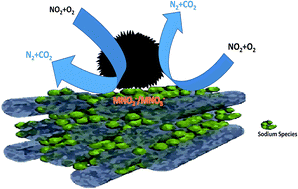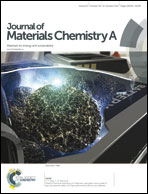Surface sodium functionalization of ordered mesoporous Co3O4 controls the enhanced simultaneous catalytic removal of soot and NOx†
Abstract
Nanocasting is a common strategy for creating nanostructured porous materials. The last step of the nanocasting process is the removal of the hard template to obtain the final replica. Here using Co3O4 as a model catalyst for the simultaneous soot–NOx removal reaction, we illustrate that the silica mold removal step, using hot sodium hydroxide (NaOH) or dilute hydrofluoric acid (HF) solutions, will significantly influence the final catalytic activity. Ordered mesoporous Co3O4 using HF to remove the template (m-Co3O4–F) exhibited slightly higher activity over bulk Co3O4 synthesized by the sol–gel method (b-Co3O4–S). While mesoporous Co3O4 obtained with a similar process using NaOH (m-Co3O4–Na) exhibited excellent activity in soot combustion and NOx reduction. The yield of N2 for m-Co3O4–Na was almost twice the amount of b-Co3O4–S. Experimental results reveal that NOx is stored as unstable nitrate species over m-Co3O4–Na due to the existence of homogeneous sodium species introduced by the removal process, hence favoring the oxidation of soot and reduction of NOx. This result not only highlights the importance of the NO reaction pathway in the simultaneous soot–NOx removal reaction but also affords a facile route to functionalize mesoporous oxide surface properties by varying the removal procedures, which unlocks strategies to optimize other reactions employing mesoporous materials synthesized by the nanocasting method.



 Please wait while we load your content...
Please wait while we load your content...